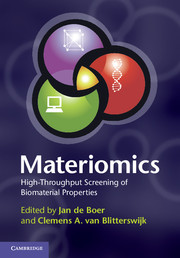Book contents
- Frontmatter
- Contents
- List of contributors
- Preface
- Chapter 1 Introducing materiomics
- Chapter 2 Physico-chemical material properties and analysis techniques relevant in high-throughput biomaterials research
- Chapter 3 Materiomics using synthetic materials: metals, cements, covalent polymers and supramolecular systems
- Chapter 4 Microfabrication techniques in materiomics
- Chapter 5 Bioassay development
- Chapter 6 High-content imaging
- Chapter 7 Computational analysis of high-throughput material screens
- Chapter 8 Upscaling of high-throughput material platforms in two and three dimensions
- Chapter 9 Development of materials for regenerative medicine: from clinical need to clinical application
- Chapter 10 Non-biomedical applications of materiomics
- Chapter 11 Beyond bed and bench
- Index
- References
Chapter 3 - Materiomics using synthetic materials: metals, cements, covalent polymers and supramolecular systems
Published online by Cambridge University Press: 05 April 2013
- Frontmatter
- Contents
- List of contributors
- Preface
- Chapter 1 Introducing materiomics
- Chapter 2 Physico-chemical material properties and analysis techniques relevant in high-throughput biomaterials research
- Chapter 3 Materiomics using synthetic materials: metals, cements, covalent polymers and supramolecular systems
- Chapter 4 Microfabrication techniques in materiomics
- Chapter 5 Bioassay development
- Chapter 6 High-content imaging
- Chapter 7 Computational analysis of high-throughput material screens
- Chapter 8 Upscaling of high-throughput material platforms in two and three dimensions
- Chapter 9 Development of materials for regenerative medicine: from clinical need to clinical application
- Chapter 10 Non-biomedical applications of materiomics
- Chapter 11 Beyond bed and bench
- Index
- References
Summary
Scope
To screen biomaterials in a materiomics approach, libraries of materials are produced. Different materials are used, varying from metals and cements, to covalent polymers that can be either premixed or polymerized in situ, to supramolecular systems that can be applied in a modular approach. This chapter describes the generation of such libraries using different kinds of materials and chemistries. Additionally, the advantages and limitations of the application of these different systems/biomaterials in a materiomics approach are discussed.
Introduction
Different synthetic biomaterials are used for many biomedical applications, varying from metals and ceramic cements, to polymers and supramolecular systems. To screen these biomaterials in a materiomics approach, as said above, libraries of materials are produced. Variations in biomaterials are screened as continuous gradients or in a discrete fashion. The properties that are varied and methods used to create variation within these libraries depend on the type of biomaterial. For the hard metal and ceramic-based biomaterials, the surface interaction with tissue is the property of most interest, and therefore properties such as surface roughness and topography are varied. Covalent polymers are diversified using combinatorial chemistry. The dynamic and self-assembling nature of supramolecular systems allows for the development of material libraries using a modular approach by mixing and matching of different compounds modified with supramolecular moieties.
- Type
- Chapter
- Information
- MateriomicsHigh-Throughput Screening of Biomaterial Properties, pp. 31 - 50Publisher: Cambridge University PressPrint publication year: 2013



